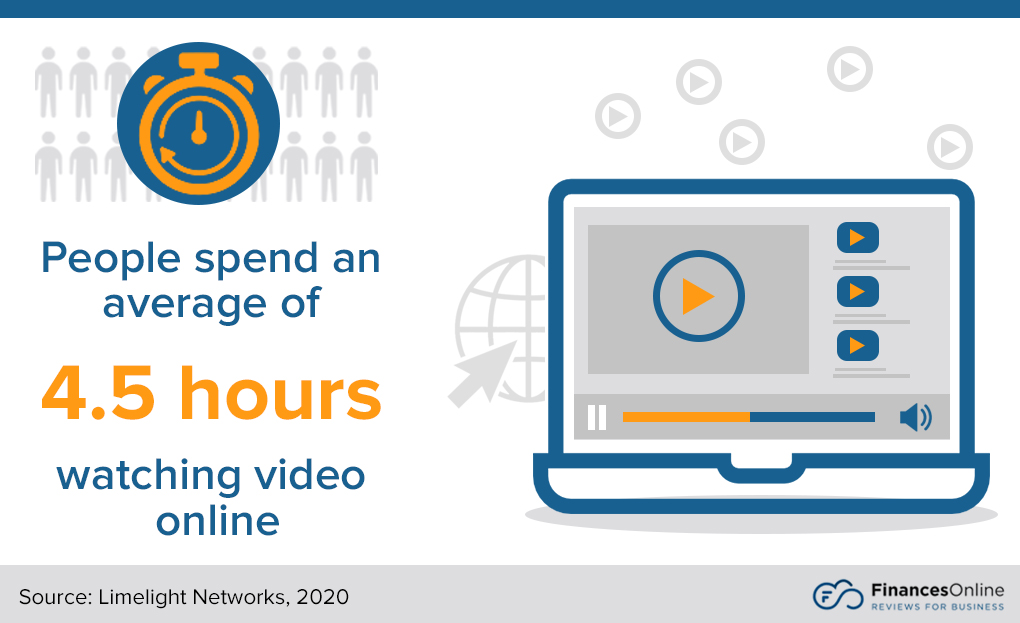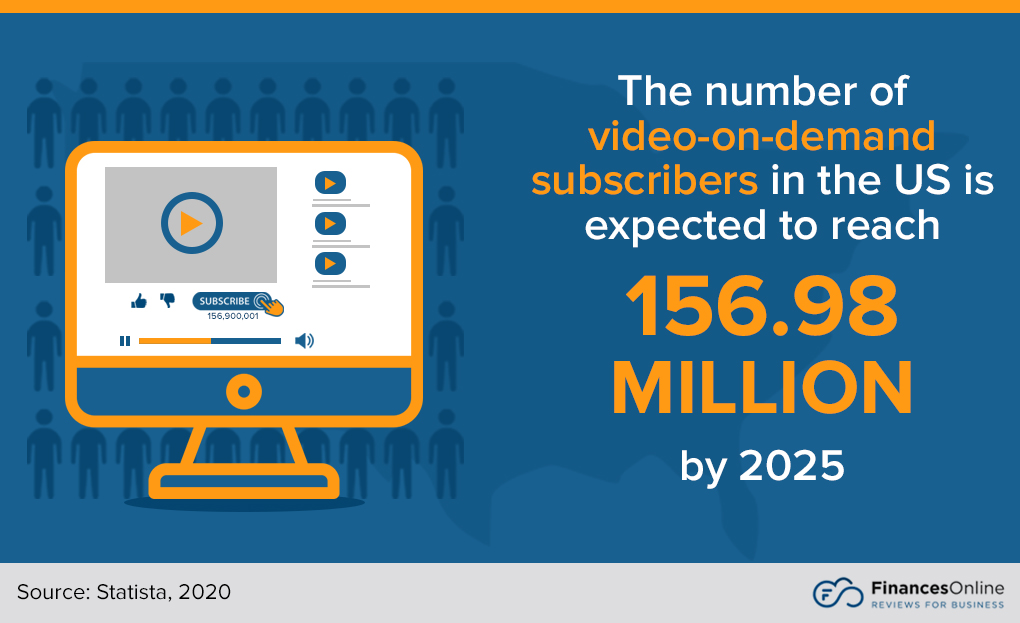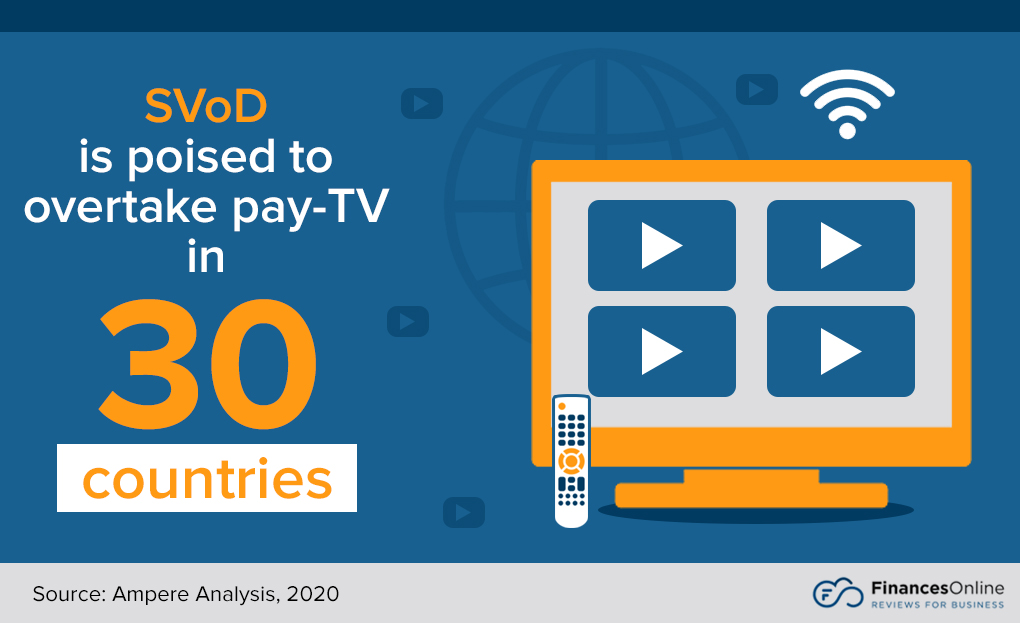Americans pay for three streaming services on average. That means that if they like the content on a new platform, they are more than willing to say goodbye to one current service. Even if they do not cut off a brand completely, often, they will just downgrade their subscription.
Instead, consumers are choosing to cut the cord: saying goodbye to pay-TV and cable TV. The numbers don’t lie, as the cord-cutting statistics tell below.

Compelling Cord-Cutting Statistics Table of Contents
General Cord-Cutting Statistics
With myriad options available through video-on-demand services online, cord-cutting and cord-trimming are on the rise. A survey even showed that 76% of consumers are happy with their video streaming services (PwC, 2019).
Cord-Cutting and Video Streaming Behaviors
- 90% of people are watching video content online. (PwC, 2019)
- People would spend an average of 4.6 hours watching TV shows. (Limelight Networks, 2020)
- Movies would get 4.5 hours of their online video viewing time. (Limelight Networks, 2020)
- In the UK, people spent 1.695 billion minutes watching content on BVoD platforms. This was only during the week of February 8 to 14, 2021. (BARB, 2021)
- 49% of Gen Z and Millennials watch short-form premium videos. (NRG & Snap, 2020)
- Meanwhile, 52% watch long-form TV content. (NRG & Snap, 2020)
- 64% who plan to subscribe to a different video streaming service would downgrade or terminate at least one current subscription. (PwC, 2019)
- 77% were accessing TV content on the Internet in 2019, compared to the 72% in 2018. (PwC, 2019)
- Cord-trimmers average 10 additional video services together with their pay-TV subscription. (PwC, 2019)
- 40% of respondents would unsubscribe from a service to fulfill their content requirements. (PwC, 2019)

How Covid-19 Affected Online Video Streaming
The COVID-19 pandemic forced people to stay at home. With nothing else to do, many turned to watch online videos, among other behavioral changes. This is one of the streaming trends observed across the board.
- Consumers watched online videos for more than four hours a day. This is four times the average pre-pandemic. (Limelight Networks, 2020)
- Over 85% of consumers worldwide watch up to six hours of video per day. (Limelight Networks, 2020)
- A survey showed that people in India consumed the most online video. They streamed an average of five hours and 16 minutes daily. (Limelight Networks, 2020)
- The lowest average online video consumption is by that of people in South Korea—3.82 hours. (Limelight Networks, 2020)
- 66% of adults in the US watched Netflix more than the previous month before the quarantine restrictions. The figure is the same for Hulu. (Watson, 2020)
- 68% of respondents shared they watched Disney+ more because of the lockdown. (Watson, 2020)
- Only 56% of US adults said they increased their content consumption on Amazon Prime Video. (Watson, 2020)
- In Q3 2020, 68% of consumers in China said they binge-watch. (Yeomans, 2021)
- In the US, 67% of respondents said they are binge-viewers. (Yeomans, 2021)
- Meanwhile, in the United Kingdom and Italy, only 63% shared having binge-watching behavior. (Yeomans, 2021)
- US consumers streamed 8 hours a day during the coronavirus lockdown. (Sadlier, 2020)
- 56% of users frequently rewatched shows rather than start something new. (Sadlier, 2020)
- More females in the US binge-watched compared to males—49% versus 48%. (Acklin, 2020)
US Adults' Streaming Behaviors During Covid-19 Lockdown
Source: nScreenMedia, 2020
Designed byVideo-on-Demand Statistics: Who’s the Biggest?
No conversation about video-on-demand is complete without pitting the top players in the industry against each other. Check out who’s who in this booming industry.
Market Share
- The number of video-on-demand users in the United States is expected to grow to 156.98 million by 2025 (Stoll, 2021).
- In Q4 2020, Netflix had 203.67 million subscribers worldwide. US-based subscribers account for more than 73 million of the platform’s users. (Netflix, 2021)
- Hulu had 36.6 million subscribers in the US at the end of Q4 2020. (Walt Disney, 2021)
- Disney+ had 73.7 million subscribers worldwide by the end of Q4 2020. (Walt Disney, 2021)
- Hispanic people are the largest ethnicity in the US that subscribe to Netflix at 63%. (Morning Consult, 2020)
- Netflix was the most purchased VoD brand in the US in 2020, with 82% of consumers subscribing to it. (Statista, 2020)
- HBO GO was the 7th most purchased VoD brand in the US in 2020 with a 16% market share. It is followed by HBO with 14%. (Statista, 2020)
- The OTT-based segment was the largest solution in 2020, accounting for more than 41% of the market. (GVR, 2021)
- On the other hand, the subscription model takes the lion’s share of the market, according to the revenue model, at 43%. (GVR, 2021)
- In the Asia Pacific region, China’s iQiyi is forecast to be the number one SVoD platform by 2025, with 100.67 million users. (Dziadul, 2020)
- Netflix is anticipated to have 34.29 million users by 2025 in the Asia Pacific. (Dziadul, 2020)
Revenue Talk
- 81%—that is the share of the global SVoD revenue generated by top 10 markets. (Statista, 2020)
- Netflix is forecast to have a global revenue of 23% by 2024. (Szalai, 2019)
- The predicted figure for Amazon Prime video is 13% for the same period. (Szalai, 2019)
- The US provided the largest chunk of SVoD revenue worldwide in 2019 at 43%. (Strategy Analytics, 2020)
- China contributed 17% of the total global SvoD revenue in 2019. (Strategy Analytics, 2020)

Most Popular Shows
Each online video content streaming platform is always fighting to attract more users. They do it with rich video libraries filled with TV shows and movies that suit the tastes of their audience. But they also battle it out with original titles, which is one of the main points of comparison between video streaming services. These services must be doing a good job because 73% of consumers were satisfied with the quality of original content they were getting (PwC, 2019).
- From February 7 to 13, 2021, The Mandalorian on Disney+ had 63.6 million average demand expressions. (Parrot Analytics, 2021)
- In the same period, Cobra Kai on Netflix, based on the Karate Kid film series, garnered 62.6 million average demand expressions. (Parrot Analytics, 2021)
- Mini-series WandaVision, another Disney+ title, had 61.2 million average demand expressions. (Parrot Analytics, 2021)
Source: Parrot Analytics, 2021
Impact of Cord-Cutting on Paid TV Statistics
As even major cable channels are putting their content online, many people are opting to cut cords. Meanwhile, other consumers are cord-trimming rather than say goodbye to pay-TV for good. Because other than numerous video streaming options online, people now have the choice to use media streaming gadgets.
- In 2019, 68% of respondents said they still use pay-TV. In the previous year, it was 67%. However, the period 2017-2018 saw a decline of 6%. (PwC, 2019)
- 29% of consumers are cord-trimming. (PwC, 2019)
- 23% of respondents are cord-cutters. (PwC, 2019)
- 9% of people described their relationship with pay-TV as cord-never. (PwC, 2019)
- SVoD is poised to overtake pay-TV in 30 countries. (Yeomans, 2020)
- Digital cable TV revenue is predicted to reach only $81.92 billion in 2022 compared to $86.16 billion in 2017. (Murray, 2018)
- Pay IPTV will have a slight increase—from $24.02 billion in 2017 to $25.33 billion in 2022. (Murray, 2018)
- There will be a marked decrease in the number of pay-TV subscribers in the US by 2025. From 79.24 million to 56.02 million. (Murray, 2018)
- The UK will have a similar decrease—from 6.35 million in 2020 to 5.78 million in 2025. (Digital TV Research, 2020)
- Surprisingly, India is forecast to have 6 million pay-TV subscribers in 2025, from 5.42 million in 2020. (Digital TV Research, 2020)
- Comcast Corporation’s revenue was down to $103.56 billion in 2020. In 2019, the company had revenue of $108.94 billion. (Comcast, 2021)
- British pay-TV operator Sky had a decrease in revenue as well. From £13.82 billion in 2019 to £13.39 billion in 2020. (Comcast, 2021)

Cutting the Cord: A Conscious Choice
Ever since streaming platforms became huge, people have been jumping on the SVoD wagon. As the foregoing cord-cutting statistics show, some even have multiple concurrent subscriptions. Meanwhile, others like to stream on different platforms other than SVoD services, leading to the phenomenal growth of the video streaming industry. As a result, there are those who go the route of cord-cutting. While this spells savings for consumers, pay-TV companies are left scratching their heads.
Some of the biggest operators of traditional TV, pay-TV, and cable TV have been experiencing losses as a result. The change is especially marked in the North American market. Indeed, there are now more countries where SVoD has overtaken pay-TV. However, there are still bright beacons for cable companies. But whether or not they can retain their footing in those markets is something that has to be seen in the future.
References:
- Acklin, M. (2020, April 28). More than half of Americans 13+ binge-watch. CivicScience.
- BARB. (2021). Aggregate Viewing Time by BVOD Service – 1 week. London, UK: Broadcasters’ Audience Research Board.
- Comcast. (2021). 2020 Annual Report on Form 10-K. Philadelphia, PA: Comcast.
- Digital TV Research. (2020). Global pay TV revenues down, subscriptions up. Pay TV Forecasts Update. Middlesex, UK: Digital TV Research
- Dziadul, C. (2020, March 30). Strong growth for Asia Pacific SVOD. BroadbandTV News.
- GVR. (2021). Video Streaming Market Size, Share & Trends Analysis Report By Streaming Type, By Solution, By Platform, By Service, By Revenue Model, By Deployment Type, By User, By Region, And Segment Forecasts, 2021 – 2028. San Francisco, CA: Grand View Research.
- Limelight Networks. (2020). The State of Online Video 2020. Scottsdale, AZ: Limelight Networks.
- Morning Consult & The Hollywood Reporter. (2020). National Tracking Poll #2003101, March 27-29, 2020. Washington, DC: Morning Consult; Los Angeles, CA: The Hollywood Reporter.
- Murray, S. (2018). Global Pay TV & OTT Trends. Middlesex, UK: Digital TV Research.
- Netflix (2021). Q4 2020 Financial Statements. Financial Statements. Los Gatos, CA: Netflix.
- NRG & Snap. (2020). 20/20 Vision for Mobile Video. Los Angeles, CA and Sta. Monica, CA: National Research Group and Snap.
- Parrot Analytics. (2021, February 16). TV series demand across all television platforms for the U.S. (7-13 February, 2021). Insights. Los Angeles, CA: Parrot Analytics.
- PwC. (2019). Video streaming shakeup. Consumer Intelligence Series. London, UK: PwC.
- Sadlier, A. (2020, April 14). Americans are streaming 8 hours a day during coronavirus lockdown. New York Post.
- Statista. (2020). Video-on-Demand: HBO NOW Brand Report (United States) 2020. Statista Global Consumer Survey. Hamburg, Germany: Statista.
- Stoll, J. (2021, January 13). Digital Market Outlook: users of video-on-demand in the U.S. 2017-2025, by type. Statista.
- Strategy Analytics. (2020, March 11). Press Release: Strategy Analytics: U.S. Dominates Global SVOD Revenues. Boston, MA: Strategy Analytics.
- Szalai, G. (2019, September 5). Disney+ streaming service to reach 82 million subscribers worldwide by 2024: Study. The Hollywood Reporter.
- Walt Disney (2021). The Walt Disney Company Reports First Quarter Earnings for Fiscal 2021. Burbank, CA: Walt Disney.
- Watson, A. (2020, July 17). Subscription Video On Demand in the U.S. – statistics & facts. Statista.
- Watson, A. (2020, July 9). Binge-viewing in the U.S. – statistics & facts. Statista.
- Yeomans, A. (2021, January 12). Can traditional broadcasters lure audiences back from SVoD services? Insights. London, UK: Ampere Analysis.






















Leave a comment!